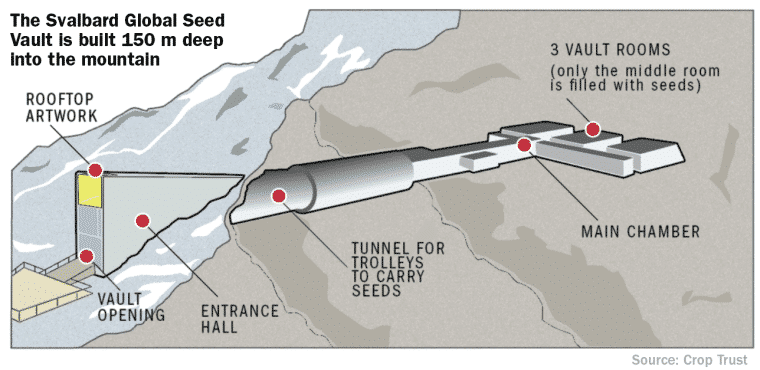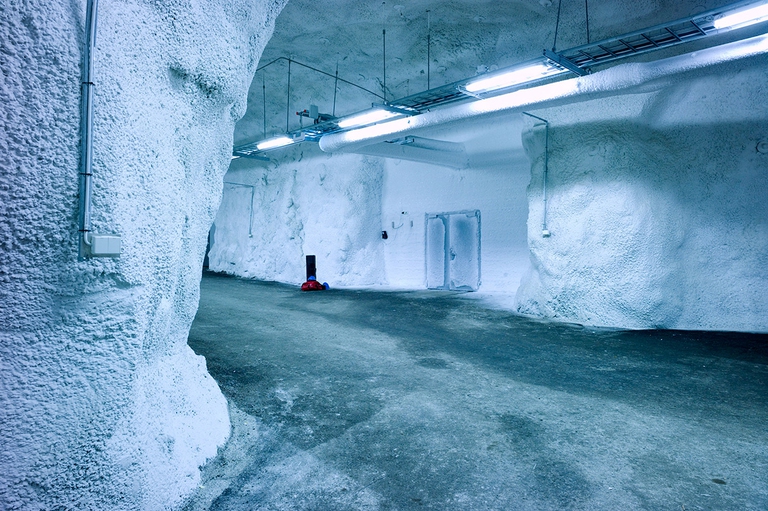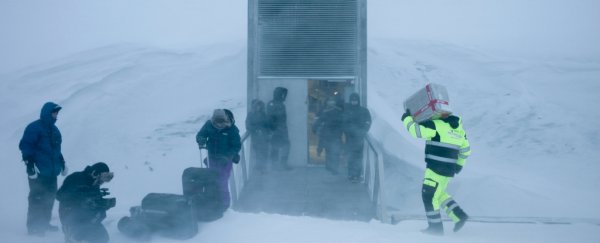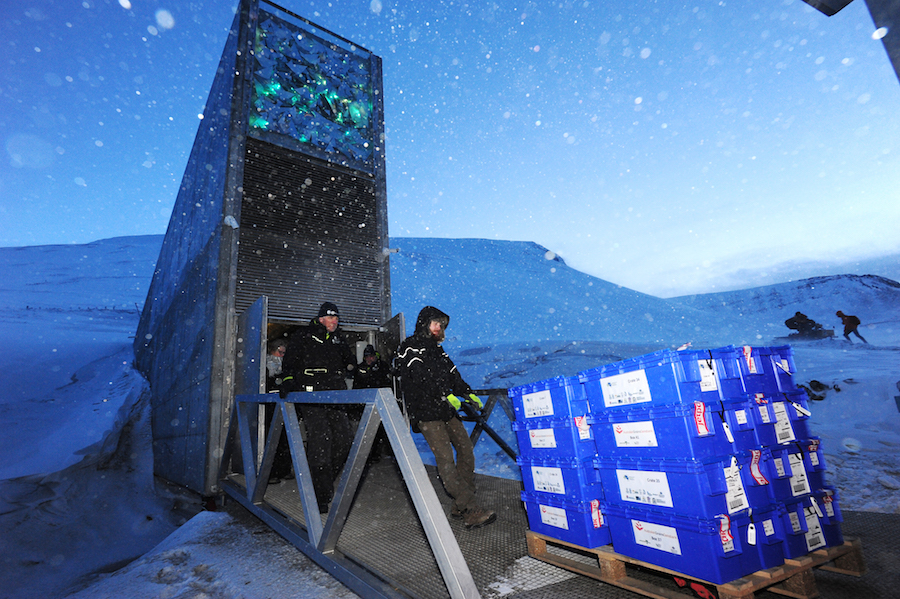What do you picture when the land of midnight sun, Norway crosses your mind? It must be white snowy terrain, crystal-like blue glaciers, magical dancing aurora, astounding fjords, wild polar bears, scenic landscapes, intriguing cultural heritage, and all the mind-boggling aspects.

But little do we know, this land is accommodating a treasure of immeasurable worth, world’s most precious collection of seeds on its faraway island Svalbard; known as the Svalbard Global Seed Vault aka ‘Doomsday’ Vault, which is the largest seed vault in the world.
Seed-fortress on the northernmost point of the earth? Yes!
This seed vault is located on the island of Spitsbergen, in the remote arctic Svalbard archipelago, Norway. It’s the northernmost zone one can land via regular commercial flight.

This remote site was chosen premeditatedly based on its steady geology and geographical position and the climate being inordinately cold. In addition, the tectonic plate under Svalbard is nearly seismically inactive along with an isolated geopolitical locus which ensures the seed vault’s invulnerability.
Framework of the vault
On the mystic island of Spitsbergen, the seed vault protrudes out of the permafrost of exalted Platåberget mountain. Standing like a monolith, the vault’s quadrangular entrance is illuminated spectacularly. The vault was designed by Norwegian architect Peter W. Søderman.

The irradiated fiber optic art installations on the gateway leads to long cylindrical tunnel, more than 100 meters into the mountain. The tunnel terminates in a chamber, which commences 3 separate vault rooms, among which, only vault 2 aka the middle one is being used. Inside the vault, roof-touching shelves are standing upright, containing boxes full of diverse seeds that traveled from tropical to the farthest corner of the earth. They may be of little material worth but possess the potential of saving the earth from any possible irrevocable crop diversity loss.
How does it work?
1,194,94 seed samples of 5,974 species are stocked in the frigid cold vaults, where temperature is cooled to -18°Celsius, and low humidity are maintained. This freezing temperature is a prerequisite to retain seed viability. Airtight metal bags of aluminum with specialized 3-layered packaging are used to store dried seeds.

The vault is curved inside mountain permafrost because it’s considered failsafe, if any adversity dawns upon and there’s a power failure, permafrost’s natural temperature will safeguard the seeds. However, as the expeditious global warming is marching onward, seed vault faced a recent breach in 2017. The icy permafrost melted due to temperature rise and it inundated the entrance, only fortunately it froze into a glacier and couldn’t touch the vault nor the seeds.
Wreckage of war and first withdrawal of seeds
Solemn significance of the seed vault was first direly seen when Syria had to withdraw its deposited seeds in 2015. On that very year, there was an attack on Aleppo (a city in Syria) during the Syrian civil war, and the entire seed collection of ICARDA was annihilated.

However, fortunately, almost 118,400 of 148,000 seeds had been replicated and transferred to Svalbard. Those withdrawn seeds were recuperated and reconstructed into new collections in Lebanon and Morocco. This type of phenomenon is indeed disheartening and exasperating but at the same time apparent attestation of the importance of the seed vault.
Accessibility and Regulations for protection
Svalbard seed vault is considered one of the most protected and restricted places on earth. Without prior authorization, visitors aren’t permitted, even no on-site employees are employed full time. Nevertheless, NordGen (Nordic Genetic Resource Center) deploys workforce when new deposit arrives, besides, Stasbygg (Norwegian Directorate of Public Construction and Property) is in charge of maintaining and monitoring the seed vault.

The depositors are the sole owners of the seeds which are reserved under “black box condition” and can withdraw them anytime. Storage of genetically modified seeds is strictly prohibited by law. Although, storing seeds is free of cost but depositors must agree to allow their seeds to be used for scientific research and plant breeding, additionally, contributors have to ensure that their deposits are duplicated elsewhere beside this vault, and this is a secondary backup.
Since 1990s earth has lost almost 75% of plant genetic diversity and this loss is irremediable. It’s important to render a safe haven for the remaining plants, more specifically, their seeds, as our future food security depends on it.

If by worse luck, any catastrophe really does occur to wipe out our crops, (which is more likely to happen), we will be having a savior to bring them back to the earth. Svalbard seed vault, being the largest and most efficient one of its kind is a pioneer in this case, housing 930000 crop variety, protecting world’s one of the most valuable resources from wrath of war and nature, uncertainty and possible demolitions.
References
 Plantlet The Blogging Platform of Department of Botany, University of Dhaka
Plantlet The Blogging Platform of Department of Botany, University of Dhaka






good work
Amazing writing looking forward to read more from the author.
Cool info.
This is my first time pay a quick visit at here and i am really happy to read everthing at one place
Your article helped me a lot, is there any more related content? Thanks!
I appreciate you sharing this blog post. Thanks Again. Cool.
We just wanted to take a moment to acknowledge all the hard work and effort you’ve been putting in lately. Keep up the amazing job, you’re doing great!
Thank you so much for your Valuable comment. We wish to hear from you again.
I just wanted to take a moment to say how much I appreciate your blog posts. They’re always well-written, informative, and keep me coming back for more. Keep up the great work!
Thank you so much for your Valuable comment. We wish to hear from you again.
You’re so awesome! I don’t believe I have read a single thing like that before. So great to find someone with some original thoughts on this topic. Really.. thank you for starting this up. This website is something that is needed on the internet, someone with a little originality!
Thank you so much for your Valuable comment. We wish to hear from you again.
Awesome! Its genuinely remarkable post, I have got much clear idea regarding from this post
Thank you so much for your Valuable comment. We wish to hear from you again.
Nice post. I learn something totally new and challenging on websites
Thank you so much for your Valuable comment. We wish to hear from you again.
Their posts always leave us feeling informed and entertained. We’re big fans of their style and creativity.
Thank you so much for your Valuable comment. We wish to hear from you again.
Let us know in the comments which of their posts has resonated with you the most.
This was beautiful Admin. Thank you for your reflections.
Thank you so much for your Valuable comment. We wish to hear from you again.
From start to finish, your content is simply amazing. You have a talent for making complex topics easy to understand and I always come away with valuable insights.
Thank you so much for your Valuable comment. We wish to hear from you again.
Awesome! Its genuinely remarkable post, I have got much clear idea regarding from this post
Thank you so much for your Valuable comment. We wish to hear from you again.
Every time I read one of your posts, I come away with something new and interesting to think about. Thanks for consistently putting out such great content!
Thank you so much for your Valuable comment. We wish to hear from you again.
I appreciate you sharing this blog post. Thanks Again. Cool.
Thank you so much for your Valuable comment. We wish to hear from you again.
I’m often to blogging and i really appreciate your content. The article has actually peaks my interest. I’m going to bookmark your web site and maintain checking for brand spanking new information.
Thank you so much for your Valuable comment. We wish to hear from you again.
Hi there to all, for the reason that I am genuinely keen of reading this website’s post to be updated on a regular basis. It carries pleasant stuff.
Thank you so much for your Valuable comment. We wish to hear from you again.
Great information shared.. really enjoyed reading this post thank you author for sharing this post .. appreciated
Thank you so much for your Valuable comment. We wish to hear from you again.
This was beautiful Admin. Thank you for your reflections.
Thank you so much for your Valuable comment. We wish to hear from you again.
Wow amazing blog layout How long have you been blogging for you made blogging look easy The overall look of your web site is magnificent as well as the content
I like the efforts you have put in this, regards for all the great content.
Hi i think that i saw you visited my web site thus i came to Return the favore I am attempting to find things to improve my web siteI suppose its ok to use some of your ideas
Simply desire to say your article is as surprising. The clearness in your post is simply excellent and i could assume you are an expert on this subject. Fine with your permission let me to grab your feed to keep up to date with forthcoming post. Thanks a million and please carry on the gratifying work.
I simply enjoy the useful details you provide in your writings.
Wow superb blog layout How long have you been blogging for you make blogging look easy The overall look of your site is magnificent as well as the content
I have read some excellent stuff here. Definitely value bookmarking for revisiting. I wonder how much effort you put to make the sort of excellent informative website.
Hi my family member! I want to say that this post is awesome, nice written and come with approximately all significant infos. I would like to peer extra posts like this.
What i do not realize is in fact how you are no longer actually much more well-favored than you might be right now. You’re very intelligent. You recognize thus considerably in relation to this topic, made me in my view believe it from numerous numerous angles. Its like men and women are not fascinated until it is one thing to do with Lady gaga! Your own stuffs excellent. All the time handle it up!
I do not even know how I ended up here, but I thought this post was great. I do not know who you are but certainly you’re going to a famous blogger if you are not already 😉 Cheers!
I have been surfing online more than 3 hours today yet I never found any interesting article like yours It is pretty worth enough for me In my opinion if all web owners and bloggers made good content as you did the web will be much more useful than ever before
What i do not realize is in fact how you are no longer actually much more wellfavored than you might be right now Youre very intelligent You recognize thus considerably in relation to this topic made me in my view believe it from numerous numerous angles Its like men and women are not fascinated until it is one thing to do with Lady gaga Your own stuffs excellent All the time handle it up
I do trust all the ideas youve presented in your post They are really convincing and will definitely work Nonetheless the posts are too short for newbies May just you please lengthen them a bit from next time Thank you for the post
Attractive section of content I just stumbled upon your blog and in accession capital to assert that I get actually enjoyed account your blog posts Anyway I will be subscribing to your augment and even I achievement you access consistently fast
I was suggested this web site by my cousin Im not sure whether this post is written by him as no one else know such detailed about my trouble You are incredible Thanks
Your blog posts are a great source of information.
This is exactly what I was looking for, thank you for the clarity.
I have read some excellent stuff here Definitely value bookmarking for revisiting I wonder how much effort you put to make the sort of excellent informative website
For the past few days I’ve been frequently checking out this wonderful site, they produce first-rate content for fans. The site owner works hard to captivate readers. I’m thrilled and hope they continue providing superb material.
very informative articles or reviews at this time.
For the reason that the admin of this site is working, no uncertainty very quickly it will be renowned, due to its quality contents.
I am truly thankful to the owner of this web site who has shared this fantastic piece of writing at at this place.
I like the efforts you have put in this, regards for all the great content.
very informative articles or reviews at this time.
I truly appreciate your technique of writing a blog. I added it to my bookmark site list and will
For the reason that the admin of this site is working, no uncertainty very quickly it will be renowned, due to its quality contents.
naturally like your web site however you need to take a look at the spelling on several of your posts. A number of them are rife with spelling problems and I find it very bothersome to tell the truth on the other hand I will surely come again again.
Awesome! Its genuinely remarkable post, I have got much clear idea regarding from this post